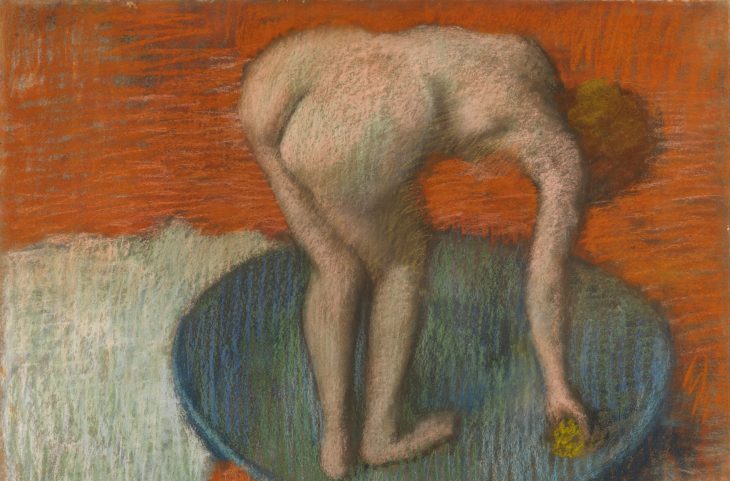Where was Degas standing as he sketched his ‘Laundresses’ (c.1882–4)? Did he watch the two women from behind sheets hanging to dry? Or was he hidden by steam from the basins? The laundry women are unselfconscious, unguarded. One reads aloud from a list, calling out shirts, collars, cuffs to be washed and ironed. Another leans over her workbench, staring into the placket of a folded shirt like Narcissus into his pool. Neither is the least bit bothered by the artist making a rapid chalk sketch to be worked up later in pastel. Nor the two men in ‘At the Café de Châteaudun’ (c.1869–71), reading a newspaper with monocle and magnifying glass. Degas might be peering at them over the top of his menu. A coffee, a croissant, a sneaking sketch.
In ‘Women in a Theatre Box’ (c.1885–90), Degas has misread his ticket and barged in on the wrong seats. The two women, mid-gossip, haven’t noticed the snoop at the back of the box. You imagine Degas sketching rapidly, eavesdropping furiously, before retreating, still not spotted by his unwitting sitters.
There is something of the paparazzo about Edgar Degas (1834–1917). ‘Click!’ goes the shutter of his eye. A fleeting moment, a snapshot, a candid close-up. He catches his subjects unaware, off-duty, yawning, fidgeting, in ungainly, in-between poses, tying a slipper lace, adjusting a pinching shoulder strap. He is master of the zoom lens, prying, spying, fascinated. ‘It is as if you looked through a keyhole,’ he said.
There is a tension in his sketches. On the one hand, the rapt intensity of his gaze. On the other, a need for rapid expression: swift chalk strokes, firework dashes of pastel, brisk scribbles of colour as in the grass background of his ‘Russian Dancers’ (1899).









Comments
Join the debate for just £1 a month
Be part of the conversation with other Spectator readers by getting your first three months for £3.
UNLOCK ACCESS Just £1 a monthAlready a subscriber? Log in